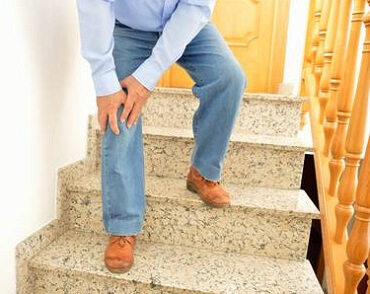Knee pain when climbing or descending stairs can be frustrating and limit your daily activities. Whether it’s due to arthritis, weak muscles, or an old injury, taking the right steps can help ease discomfort and improve mobility. The good news is that you can apply instant solutions to reduce knee pain and make stair movements easier.
In this article, we’ll explore quick fixes, long-term strategies, and prevention tips to help you manage knee pain when using stairs.
Why Does Knee Pain Happen on Stairs?

Knee pain when going up or down stairs is often caused by:
- Patellofemoral Pain Syndrome (Runner’s Knee) – The kneecap doesn’t track properly, leading to pain.
- Osteoarthritis – The breakdown of cartilage makes knee movement painful.
- Weak Quadriceps and Hamstrings – Weak muscles put extra strain on the knee joint.
- Meniscus Tears – Damage to the knee’s cushioning cartilage can cause pain when bending.
- Ligament Injuries – Strained or torn ligaments affect knee stability.
Instant Fixes for Knee Pain on Stairs
If you need quick relief when climbing or descending stairs, try these solutions:
1. Use the “Good Leg First” Technique
- When going up, lead with your stronger (pain-free) leg.
- When going down, lead with your weaker (painful) leg while using support.
This reduces strain on the affected knee.
2. Engage Your Core and Hips
- Keep your posture upright and engage your core muscles.
- Shift weight to your hips rather than your knees.
This distributes pressure more evenly.
3. Use a Handrail for Support
Holding onto a handrail reduces stress on the knees and provides stability.
4. Wear Supportive Footwear
Shoes with proper arch support and cushioning absorb impact and reduce knee strain.
5. Apply Ice or Heat Before Using Stairs
- Ice: Reduces inflammation and numbs pain.
- Heat: Relaxes muscles and improves blood flow.
Applying for 15-20 minutes before activity can help.
6. Use a Knee Brace or Compression Sleeve
A knee brace provides stability, while compression sleeves reduce swelling and pain.
Strengthening Exercises for Long-Term Relief
Strengthening the muscles around the knee can help reduce pain over time. Try these exercises:
1. Quadriceps Strengthening (Straight Leg Raises)
- Sit or lie down and extend your leg straight up.
- Hold for 5 seconds, then lower slowly.
- Repeat 10-15 times on each leg.
2. Step-Ups (For Stair Strengthening)
- Step up onto a stable platform or low step.
- Use your leg muscles (not just your knee) to lift yourself up.
- Step down slowly and repeat.
Also Read: Knee Pain Metaphysical Meaning – What Your Body is Trying to Tell You!
3. Hamstring Curls
- Stand and bend one knee back, bringing your heel toward your glutes.
- Hold for 3-5 seconds and release.
4. Wall Sits
- Stand with your back against a wall and slide down into a squat position.
- Hold for 10-30 seconds.
- Repeat 3-5 times.
Prevention Tips to Avoid Knee Pain on Stairs
- Maintain a Healthy Weight – Extra weight increases knee stress.
- Stretch Daily – Keep muscles flexible to prevent stiffness.
- Stay Active – Low-impact activities like swimming or cycling strengthen the knees.
- Modify Your Stairs – Use anti-slip stair treads or install a stairlift if necessary.
When to See a Doctor
If knee pain persists despite trying these fixes, consult a doctor if you experience:
✅ Persistent swelling or stiffness
✅ Sharp pain that worsens over time
✅ A popping sensation followed by pain
✅ Difficulty walking or bearing weight
FAQ’s
1. Why does my knee hurt when going up and down stairs?
Knee pain on stairs is often due to conditions like patellofemoral pain syndrome, osteoarthritis, weak muscles, meniscus tears, or ligament injuries. These issues cause instability, inflammation, and discomfort when bending the knee.
2. What is the quickest way to reduce knee pain when using stairs?
Using the “good leg first” technique, engaging your core, using a handrail for support, and wearing cushioned footwear can provide instant relief. Applying ice or heat before activity can also help.
3. Should I avoid stairs if I have knee pain?
It’s best to use stairs carefully rather than avoid them entirely. Strengthening exercises and proper techniques can help reduce strain and improve mobility over time.
4. Can wearing a knee brace help with stair-related knee pain?
Yes, a knee brace provides stability and reduces strain, while a compression sleeve can help minimize swelling and discomfort.
5. What exercises strengthen the knee for stair climbing?
Quadriceps strengthening (straight leg raises), step-ups, hamstring curls, and wall sits can improve knee strength and reduce pain when using stairs.
6. How can I prevent knee pain when using stairs?
Maintaining a healthy weight, stretching daily, staying active with low-impact exercises, and modifying stairs (such as using anti-slip treads) can help prevent knee pain.
7. When should I see a doctor for knee pain on stairs?
If you experience persistent swelling, sharp pain that worsens, a popping sensation, or difficulty walking, consult a doctor for proper diagnosis and treatment.
8. Is knee pain on stairs a sign of arthritis?
It could be, especially if accompanied by stiffness, swelling, and a gradual increase in discomfort. A doctor can confirm arthritis and recommend treatment options.
Final Thoughts
Knee pain when going up and down stairs doesn’t have to control your life. By using these instant relief tips, strengthening exercises, and prevention methods, you can reduce discomfort and move with confidence. If the pain continues, seek medical advice for a personalized treatment plan.
Related Post
- Zimatejigemo – Unlocking the Fusion of Creativity, Identity, and Innovation!
- Tinaypimatelate – The Revolutionary Concept Shaping the Future of Innovation!
- Limhuloxidpov – A Complete Guide to Understanding This Unique Concept!
- Zaxtexporoz – Exploring the Emerging Concept of Innovation and Digital Transformation!
- Lekulent – The Breakthrough Wellness Solution Taking the Health World by Storm!






